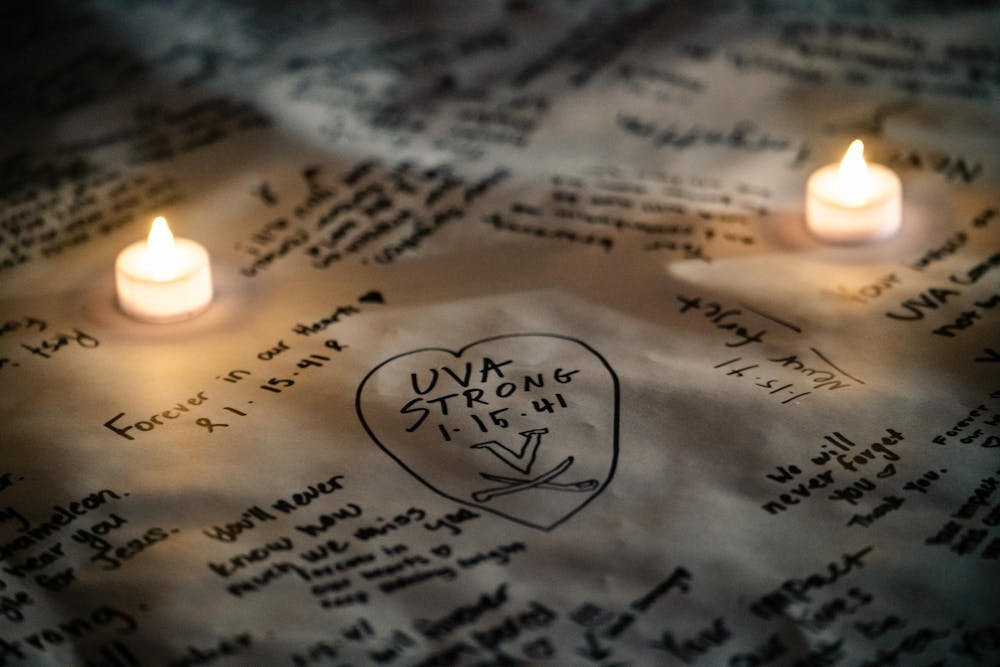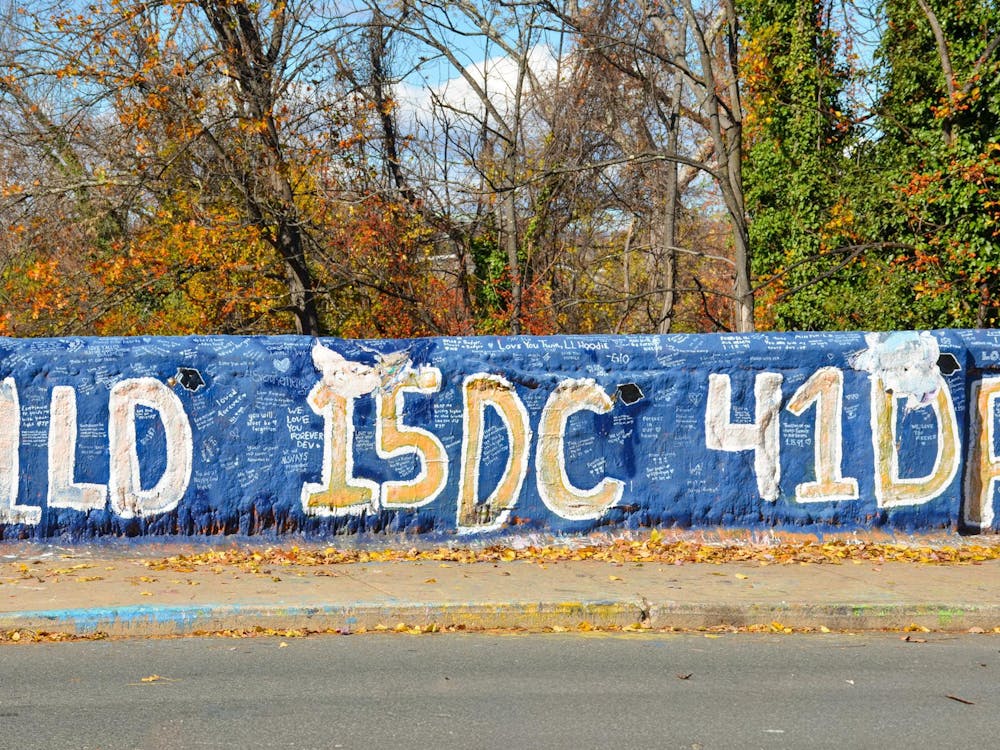As the University reaches the three-year anniversary of the Nov. 13, 2022 shooting, institutional reforms to campus safety remain a central concern for students, faculty and families. In the years since the attack and following external reviews of the incident, the University has reshaped its threat assessment infrastructure, expanded emergency alert systems, reorganized student accountability operations and significantly built out mental health services.
The tragedy of Nov. 13, 2022 unfolded when Christopher Darnell Jones Jr. shot five students on a bus headed back from Washington, killing Lavel Davis Jr., D’Sean Perry and Devin Chandler, and injuring Mike Hollins and Marlee Morgan. The University remained under lockdown for 12 hours while law enforcement worked to locate Jones.
Parents of the victims have questioned whether the tragedy could have been prevented. Happy Perry, the mother of D’Sean Perry, has previously said the University had warning signs and should have acted sooner, arguing that earlier intervention could have changed the outcome for the students who were killed or injured and those who continue to live with the trauma.
Two external reviews conducted by external firms at the request of the University determined that the University likely could not have prevented the shooting with the information available. But the reports still made several recommendations on how to improve threat assessment infrastructure and alert systems.
In a statement to The Cavalier Daily, University Spokesperson Bethanie Glover detailed dozens of policy updates, internal restructurings and service expansions since 2022.
Centralizing threat response
One of the University’s most significant changes was the creation of the Office of Threat Assessment at the beginning of 2023, designed to centralize behavioral threat analysis and crisis response. Glover detailed the scope and intent of the office, noting its role in case coordination, intervention and specialized staffing.
“Under the supervision of the Director of Threat Assessment, the Office ensures that case assessment, investigations and critical threat assessment team recommendations are carried out by trained subject matter experts in behavioral threat assessment and management,” Glover said.
An external review, requested by the University and conducted by Quinn Emanuel Urquhart & Sullivan, found that prior to the 2022 shooting, the University lacked a system to ensure threat assessment recommendations were enforceable. The report concluded that the University did not have “any independent authority to compel compliance with its investigation,” meaning students could decline to participate in safety interventions with limited administrative recourse.
Glover added that since January 2023, the Office of Threat Assessment has evaluated 1,815 reports and completed 495 comprehensive evaluations. In cases that required comprehensive evaluation, the OTA has carried out 5,736 management interventions, including psychiatric referrals, trespass orders, criminal investigations, security increases, supporter service referrals, and interim suspensions.
According to University policy, an interim suspension is when a University official temporarily suspends a student that is reasonably believed to pose a threat to themselves, others, University property or the educational process.
Emergency alert expansion
Following criticism of communication delays from the Vinson & Elkins external review of the 2022 shooting, the University overhauled its emergency alert structure. Text alerts are now automatic for the entire University community unless manually opted out, as opposed to previously, when text alerts were opt-in.
“U.Va. Alerts are issued to the community quickly upon confirmation of an emergency or dangerous situation. University leadership is immediately involved when situations like this arise, allowing us to activate U.Va. Alerts within moments of confirming a report of an emergency or dangerous situation,” Glover said.
According to Glover, the opt-out format drastically increased emergency text reach, noting that prior to switching, the University averaged approximately 30 percent of the accounts in U.Va. Alerts having a mobile number associated with them, compared to recent statistics that 77 percent of accounts have an associated mobile number.
Additionally, Glover said more than 16,000 community members without U.Va. Alert accounts have enrolled manually, and notifications now average every 15 minutes during active alerts.
During the false report of an active shooter that placed the University on lockdown Nov. 3, alerts did go out nearly every 15 minutes that provided details on the situation. Glover noted that the alert was first issued to the community within moments of the original report of an active threat.
The speed of those alerts was in contrast to a shelter-in-place order earlier in the year. The University was locked down for five hours Feb. 25 after a man fled a traffic stop and car accident. Several students and staff reported experiencing delays in email alerts during that lockdown which the University attributed these delays to a surplus of emails being sent at the time of the emergency.
The University also formalized policies for the outdoor siren system after external reviews noted that the siren did not go off during the Nov. 13, 2022 shooting. During the false report of an attack Nov. 3, the emergency siren did go off.
“Clear guidelines have been established for the siren system to be activated for active attacker situations and for a tornado warning,” Glover said.
The University also launched the U.Va. Ready mobile app in August 2024, which is a centralized location to receive emergency alerts, report incidents, access university maps and emergency procedures.
“We understand that the number of notifications received during an emergency may feel overwhelming, but it’s critical that these alerts reach as much of our community as possible, as quickly as possible and as often as possible to ensure our students and employees know what to do to remain safe in crisis situations,” Glover said.
Mental health and crisis support
The University’s mental health infrastructure has undergone its own expansion following the external reviews. The University has formalized Care and Support Services, which is a non-clinical resource available to help students navigate a variety of challenges, and can be used for students in distress.
“CASS provides immediate and ongoing coordinated support and care for students experiencing distress or crisis,” Glover said.
CASS also oversees an ongoing Care and Intervention Team, a cross-department network that meets weekly to coordinate student care with Counseling and Psychological Services and PACE.
Glover said the team meets weekly to review students in crisis and coordinate support, bringing together staff from multiple departments to determine appropriate interventions and reduce campus safety risks.
CASS also offers a “CASS on Call,” which provides urgent consultation and intervention for matters of student safety after regular hours. CAPS also expanded telehealth and embedded counseling and crisis teams, as well as primary care mental health services for mild to moderate depression and anxiety and screening to emergency or specialty mental health services when warranted.
In addition to improving mental health services, policy changes include strengthening the general security infrastructure around Grounds.
The University’s Department of Safety and Security recently consolidated operations in Zehmer Hall, a renovated facility just off Alderman Road now serving as a centralized emergency response hub.
“This facility will enable staff to promptly assemble and assume an emergency response posture to effectively support first responders at the scene, without the necessity of relocating to another area on Grounds,” Glover said.
Glover noted that the University also expanded the Ambassador safety program on Grounds, noting that they have received considerable positive feedback from the community about the expansion.
Glover said that the University has added a network of approximately 3,000 cameras on Grounds and said it gives the University the ability to respond to safety concerns or other emergencies efficiently.
Despite internal changes, Glover acknowledges that the broader regulatory environment remains limited. Currently, possession of a weapon on Grounds is only a violation of University policy, not a state crime. The University has advocated for legislation to make possession of a firearm in a college campus building illegal.
House Bill 1876, proposed by Del. Katrina Callsen, D-Charlottesville, was passed in February by the Virginia House and Senate, but ultimately vetoed by Gov. Glenn Youngkin in March. With Democrats set to hold the governor’s office following the 2025 election, lawmakers may again have the votes necessary to revisit similar legislation in a future session.
“While that proposed legislation has not been passed to date, the University plans to continue advocating for this important safety improvement that would allow University safety officials to quickly and legally address reports of firearms in U.Va. buildings,” Glover said.
Glover pointed to the Gun Violence Solutions Project, a University-wide effort to develop and implement actionable solutions to reduce gun violence, as a commitment the University has made to address this issue.
The University has made changes to many sectors since the tragedy Nov. 13, 2022. But as students who were first-years in 2022 continue to mourn and reflect on the shooting, the measure of success will be the absence of another incident.







